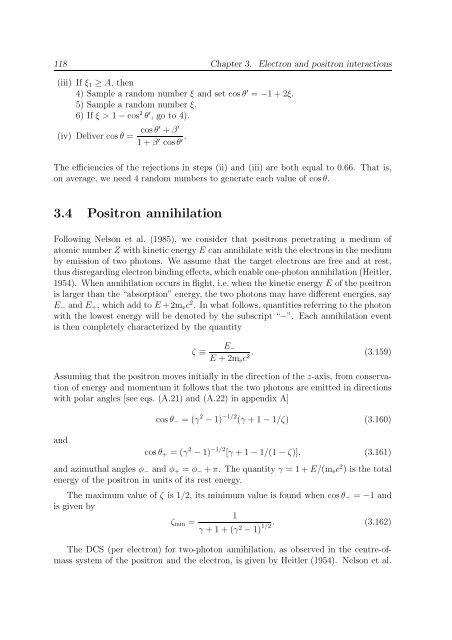PENELOPE 2003 - OECD Nuclear Energy Agency
PENELOPE 2003 - OECD Nuclear Energy Agency
PENELOPE 2003 - OECD Nuclear Energy Agency
You also want an ePaper? Increase the reach of your titles
YUMPU automatically turns print PDFs into web optimized ePapers that Google loves.
118 Chapter 3. Electron and positron interactions<br />
(iii) If ξ 1 ≥ A, then<br />
4) Sample a random number ξ and set cos θ ′ = −1 + 2ξ.<br />
5) Sample a random number ξ.<br />
6) If ξ > 1 − cos 2 θ ′ , go to 4).<br />
(iv) Deliver cos θ = cos θ′ + β ′<br />
1 + β ′ cos θ ′ .<br />
The efficiencies of the rejections in steps (ii) and (iii) are both equal to 0.66. That is,<br />
on average, we need 4 random numbers to generate each value of cos θ.<br />
3.4 Positron annihilation<br />
Following Nelson et al. (1985), we consider that positrons penetrating a medium of<br />
atomic number Z with kinetic energy E can annihilate with the electrons in the medium<br />
by emission of two photons. We assume that the target electrons are free and at rest,<br />
thus disregarding electron binding effects, which enable one-photon annihilation (Heitler,<br />
1954). When annihilation occurs in flight, i.e. when the kinetic energy E of the positron<br />
is larger than the “absorption” energy, the two photons may have different energies, say<br />
E − and E + , which add to E +2m e c 2 . In what follows, quantities referring to the photon<br />
with the lowest energy will be denoted by the subscript “−”. Each annihilation event<br />
is then completely characterized by the quantity<br />
ζ ≡<br />
E −<br />
E + 2m e c 2 . (3.159)<br />
Assuming that the positron moves initially in the direction of the z-axis, from conservation<br />
of energy and momentum it follows that the two photons are emitted in directions<br />
with polar angles [see eqs. (A.21) and (A.22) in appendix A]<br />
and<br />
cos θ − = (γ 2 − 1) −1/2 (γ + 1 − 1/ζ) (3.160)<br />
cos θ + = (γ 2 − 1) −1/2 [γ + 1 − 1/(1 − ζ)], (3.161)<br />
and azimuthal angles φ − and φ + = φ − + π. The quantity γ = 1 + E/(m e c 2 ) is the total<br />
energy of the positron in units of its rest energy.<br />
The maximum value of ζ is 1/2, its minimum value is found when cos θ − = −1 and<br />
is given by<br />
1<br />
ζ min =<br />
γ + 1 + (γ 2 − 1)<br />
1/2.<br />
(3.162)<br />
The DCS (per electron) for two-photon annihilation, as observed in the centre-ofmass<br />
system of the positron and the electron, is given by Heitler (1954). Nelson et al.
















